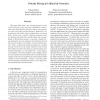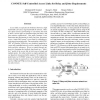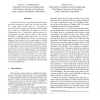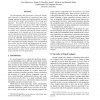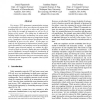ICNP
2005
IEEE
14 years 5 months ago
2005
IEEE
This paper deals with a new pricing approach in utility fair networks, where the user’s application is associated with a utility function. We allow users to have concave as well...
ICNP
2005
IEEE
14 years 5 months ago
2005
IEEE
By allowing end hosts to make routing decisions at the application level, different overlay networks may unintentionally interfere with each other. This paper describes how multip...
ICNP
2005
IEEE
14 years 5 months ago
2005
IEEE
Access links are typically the bottleneck between a high bandwidth LAN and a high bandwidth IP network. Without a priori resource provisioning or reservation, this tends to have a...
ICNP
2005
IEEE
14 years 5 months ago
2005
IEEE
In wireless networks, it is well understood what throughput can be achieved by nodes who can hear each other (i.e. nodes within a single cell)[1, 3]. The effects of nodes beyond t...
ICNP
2005
IEEE
14 years 5 months ago
2005
IEEE
This paper focuses on understanding the scale and the distribution of “state overhead” (briefly load) that is incurred on the routers by various value-added network services,...
ICNP
2005
IEEE
14 years 5 months ago
2005
IEEE
straction of Complex Network Compositions∗ Azer Bestavros, Adam D. Bradley, Assaf J. Kfoury, and Ibrahim Matta Department of Computer Science Boston University The heterogeneity...
ICNP
2005
IEEE
14 years 5 months ago
2005
IEEE
Recent experiments have taken steps towards realizing the vision of extremely large wireless sensor networks, the largest of these being ExScal, in which we
ICNP
2005
IEEE
14 years 5 months ago
2005
IEEE
Peer-to-peer (P2P) anonymous communication systems are vulnerable to free-riders, peers that use the system while providing little or no service to others and whose presence limit...
ICNP
2005
IEEE
14 years 5 months ago
2005
IEEE
A mutually anonymous service hides the identity of a client from the service provider and vice-versa. Providing mutual anonymity usually requires a large number of participants. W...
ICNP
2005
IEEE
14 years 5 months ago
2005
IEEE
